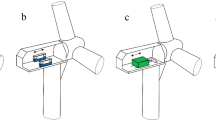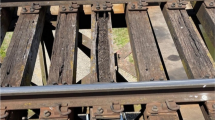Abstract
To improve the safety of trains running in an undesirable wind environment, a novel louver-type wind barrier is proposed and further studied in this research using a scaled wind tunnel simulation with 1:40 scale models. Based on the aerodynamic performance of the train-bridge system, the parameters of the louver-type wind barrier are optimized. Compared to the case without a wind barrier, it is apparent that the wind barrier improves the running safety of trains, since the maximum reduction of the moment coefficient of the train reaches 58% using the louver-type wind barrier, larger than that achieved with conventional wind barriers (fence-type and grid-type). A louver-type wind barrier has more blade layers, and the rotation angle of the adjustable blade of the louver-type wind barrier is 90–180° (which induces the flow towards the deck surface), which is more favorable for the aerodynamic performance of the train. Comparing the 60°, 90° and 120° wind fairings of the louver-type wind barrier blade, the blunt fairing is disadvantageous to the operational safety of the train.
摘要
为提高列车在复杂风环境中行车的安全性,本文采用1:40 的缩尺模型进行风洞模拟试验,针对 提出的一种新型百叶窗型风屏障对列车和桥梁的气动影响展开研究,并基于车-桥系统气动特性对百 叶窗型风屏障的自身参数进行了优化分析。试验结果表明:设置风屏障可明显提高列车运行安全性, 设置百叶窗型风屏障相对不设置风屏障列车扭矩系数减小58%;百叶窗型风屏障的防风效果优于传统 风屏障(栅栏型和多孔型)的防风效果;百叶窗型风屏障的叶片层数较多、叶片角度旋转范围在 90°~180°范围内(使气流导向桥面)时更利于列车安全运行;百叶窗叶片风嘴较钝时不利于车桥气动 安全,其中叶片风嘴角度为60°时更优,90°时最不利。
Similar content being viewed by others
References
BETTLE J, HOLLOWAY A G L, VENART J E S. A computational study of the aerodynamic forces acting on a tractor-trailer vehicle on a bridge in cross-wind [J]. Journal of Wind Engineering and Industrial Aerodynamics, 2003, 91(5): 573–592.
ZHANG Ming-jin, LI Yong-le, WANG Bin. Effects of fundamental factors on coupled vibration of wind-rail vehicle-bridge system for long-span cable-stayed bridge [J]. Journal of Central South University, 2016, 23(5): 1264–1272.
SUZUKI M, TANEMOTO K, MAEDA T. Aerodynamic characteristics of train/vehicles under cross winds [J]. Journal of Wind Engineering and Industrial Aerodynamics, 2003, 91(1): 209–218.
HE Xu-hui, WU Teng, ZOU Yun-feng, CHEN Y F, GUO Hui, YU Zhi-wu. Recent developments of high-speed railway bridges in china [J]. Structure and Infrastructure Engineering, 2017, 13(12): 1584–1595.
MATSCHKE G, SCHULTE-WERNING B. Measures and strategies to minimise the effect of strong cross winds on high speed trains [C]// Proceedings of World Congress of Railway Research (Bautechnik). Berlin: Ernst & Sohn Verlag für Architektur und technische Wissenschaften, 1997: 569–575.
IMAI T, FUJII T, TANEMOTO K, SHIMAMURA T, MAEDA, ISHIDA H, HIBINO Y. New train regulation method based on wind direction and velocity of natural wind against strong winds [J]. Journal of Wind Engineering and Industrial Aerodynamics, 2002, 90(12): 1601–1610.
RAGHUNATHAN RS, KIM H D, SETOGUCHI T. Aerodynamics of high-speed railway train [J]. Progress in Aerospace Sciences, 2002, 38(6): 469–514.
HE Xu-hui, ZOU Yun-feng, WANG Han-feng, HAN Yan, SHI Kang. Aerodynamic characteristics of a trailing rail vehicles on viaduct based on still wind tunnel experiments [J]. Journal of Wind Engineering and Industrial Aerodynamics, 2014, 135: 22–33.
HE Xu-hui, ZHOU Lei, CHEN Zheng-wei, JING Hai-quan, ZOU Yun-feng, WU Teng. Effect of wind barriers on the flow field and aerodynamic forces of a train–bridge system [J]. Proceedings of the Institution of Mechanical Engineers Part F Journal of Rail and Rapid Transit, 2018, 0(0): 1–15.
KOZMAR H, PROCINO L, BORSANI A, BARTOLI G. Optimizing height and porosity of roadway wind barriers for viaducts and bridges [J]. Engineering Structures, 2014, 81: 49–61.
FUJII T, MAEDA T, ISHIDA H, IMAI T, TANEMOTO K, SUZUKI M. Wind-induced accidents of train/vehicles and their measures in Japan [J]. Quarterly Report of Rtri, 1999, 40(1): 50–55.
GUO Wei-wei, XIA He, KAROUMI R, ZHANG Tian, LI Xiao-zhen. Aerodynamic effect of wind barriers and running safety of trains on high-speed railway bridges under cross winds [J]. Wind and Structures, An International Journal, 2015, 20(2): 213–236.
TAKEDA K, YASUDA K, TAKEUCHI M, KANEDA Y. Wind tunnel test on the performance of windbreak and snow fences [J]. Journal of Wind Engineering, 1985, 25: 15–32.
DONG Zhi-bao, LUO Wan-yin, QIAN Guang-qiang, WANG Hong-tao. A wind tunnel simulation of the mean velocity fields behind upright porous fences [J]. Agricultural and Forest Meteorology, 2007, 146(1, 2): 82–93.
DONG Zhi-bao, LUO Wan-yin, QIAN Guang-qiang, LU Ping, WANG Hong-tao. A wind tunnel simulation of the turbulence fields behind upright porous wind fences [J]. Journal of Arid Environments, 2010, 74(2): 193–207.
CHU C R, CHANG C Y, HUANG C J, WU T R, WANG C Y, LIU M Y. Windbreak protection for road vehicles against crosswind [J]. Journal of Wind Engineering and Industrial Aerodynamics, 2013, 116(5): 61–69.
COLEMAN S A, BAKER C J. The reduction of accident risk for high sided road vehicles in cross winds [J]. Journal of Wind Engineering and Industrial Aerodynamics, 1992, 44(1–3): 2685–2695.
OGUETA-GUTIÉRREZ M, FRANCHINI S, ALONSO G. Effects of bird protection barriers on the aerodynamic and aeroelastic behaviour of high speed train bridges [J]. Engineering Structures, 2014, 81: 22–34.
HE Xu-hui, SHI Kang, WU Teng, ZOU Yun-feng, WANG Han-feng, QIN Hong-xi. Aerodynamic performance of a novel wind barrier for train-bridge system [J]. Wind and Structures, 2016, 23(3): 171–189.
HOLMES J D. Wind Loading of Structures, Third Edition [M]. Boca Raton, FL: CRC Press, Taylor & Francis Group, 2015.
WANG Han-feng, PENG Si, ZHOU Yu, HE Xu-hui. Transition along a finite-length cylinder in presence of a thin boundary layer [J]. Experiments in Fluids, 2016, 57(5): 1–10.
BLEVINS R D. Applied fluid dynamics handbook [M]. Malabar, FL: Krieger Publishing Company, 1984.
HAYASHI M, SAKURAI A, OHYA Y. Wake interference of a row of normal flat plates arranged side by side in a uniform flow [J]. Journal of Fluid Mechanics, 1986, 164: 1–25.
AVILA-SANCHEZ S, LOPEZ-GARCIA O, CUERVA A, MESEGUER J. Characterisation of cross-flow above a railway bridge equipped with solid windbreaks [J]. Engineering Structures, 2016, 126: 133–146.
BAKER C J. The wind tunnel determination of crosswind forces and moments on a high speed train [M]// TRANSAERO—A European Initiative on Transient Aerodynamics for Railway System Optimisation. Berlin Heidelberg: Springer, 2002: 46–60.
HAO Zhan, PAN Xiao-min, NING Bo-wei. Self-adaptive fairing of steel box girder design and studies of flutter stability by CFD numerical simulation [C]// IABSE Congress Report. Zurich: International Association for Bridge and Structural Engineering, 2012: 1972–1979.
HAQUE M N, KATSUCHI H, YAMADA H, NISHIO M. Investigation of edge fairing shaping effects on aerodynamic response of long-span bridge deck by unsteady RANS [J]. Archives of Civil and Mechanical Engineering, 2016, 16(4): 888–900.
Author information
Authors and Affiliations
Corresponding author
Additional information
Foundation item: Project(2017T001-G) supported by the Science and Technology Research and Development Program of China Railway Corporation; Project(2017YFB1201204) supported by the National Key Research and Development Program of China; Project(U1534206) supported by the National Natural Science Foundation of China; Project(2015CX006) supported by the Innovation-driven Plan in Central South University, China; Project(2017zzts521) supported by the Fundamental Research Funds for the Central Universities, China
Rights and permissions
About this article
Cite this article
He, Xh., Fang, Dx., Li, H. et al. Parameter optimization for improved aerodynamic performance of louver-type wind barrier for train-bridge system. J. Cent. South Univ. 26, 229–240 (2019). https://doi.org/10.1007/s11771-019-3996-8
Received:
Accepted:
Published:
Issue Date:
DOI: https://doi.org/10.1007/s11771-019-3996-8




